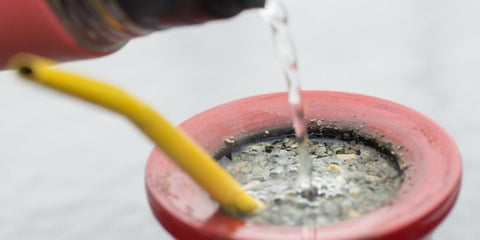Every year in South America, hundreds of thousands of tons of yerba mate are produced. In Argentina, for example, 172,000 tons are produced each year, while 80,000-120,000 tons come from Brazil and 60,000 come from Paraguay.
Yerba mate has grown in popularity over the last several years, but there's still a lot of confusion about it. Many people have questions like "What is mate tea?" and "How does tea compare to yerba mate?"
If you're on the fence about trying yerba mate, keep reading. Explained below is everything you need to know about the differences between yerba mate vs. green tea.
What Is Yerba Mate?

Yerba mate is an herb native to South America. It's one of the few plants found in the world that naturally produces caffeine (cacao, kola, guarana, tea, and coffee are the others). Green tea, on the other hand, comes from several countries in Asia, including Japan, Taiwan, China, Vietnam, and India.
The yerba mate herb is used to make the yerba mate drink. This is the national drink of Argentina, Uraguay, Paraguay, and Southern Brazil. In these countries, it's consumed six times as often as coffee.
Yerba mate is prepared as an infusion, similar to tea. However, it does not actually contain any tea leaves. A lot of people drink yerba mate in the same way they would green tea (or any other type of tea), but it's important to note that it's a totally different beverage.
The Flavor

The flavor of green tea is often light, delicate, and slightly astringent. Essentially all varieties of green tea have the same basic flavor profile.
Yerba mate, on the other hand, can range quite a bit in flavor depending on the type you drink and how the herb is prepared. It may have more of an herbaceous flavor or it could be on the sweeter side.
Powdered yerba mate tends to be more bitter. Loose-leaf varieties, in contrast, are lighter in flavor and don't contain much bitterness. Yerba mate is the least bitter when it's roasted. This gives it a richer, fragrant, and more earthy flavor.
Read Choosing Your First Yerba Mate to Try.
The Preparation

These two beverages differ in terms of preparation, too. Although they both require the same water temperature (between 160 and 180 degrees Fahrenheit), the steeping time is different.
Green tea needs to steep for about one or two minutes for the first infusion. Yerba mate, on the other hand, requires about five minutes of steeping time.
You can re-steep yerba mate more often than green tea as well. Green tea loses its flavor after being re-steeped two or three times. Yerba mate can be re-steeped up to 10 times before losing flavor.
The drinks can be served differently after their preparation, too.
All you need to prepare and serve green tea is a quality teapot. It's also possible to brew yerba mate using a teapot with a strainer, and some people also enjoy preparing it using a French press. It's very versatile and flexible (which is one of the reasons why so many people prefer it). For the traditional preparation, though, you'll use a gourd and bombilla, which is a special type of straw that also acts as a strainer.
The Health Benefits

Both yerba mate and green tea come with significant health benefits. They contain different nutrients, though, and some people will be better off drinking one instead of the other. Below is a breakdown of the differences in nutrients and health benefits between yerba mate and green tea:
Antioxidants
Yerba mate and green tea both contain antioxidants. Antioxidants are compounds that help to prevent oxidative stress and cell damage in the body.
The dominant antioxidant in green tea is epigallocatechin-3-gallate (also known as EGCG). The dominant antioxidant in yerba mate, on the other hand, is chlorogenic acid. This is the same antioxidant found in green coffee beans.
EGCG is known to provide the following health benefits:
- Slowed aging
- Improved cognitive function
- Improved heart health
- Faster weight loss via increased thermogenesis and fat oxidation
- Inhibited tumor growth (specifically in the stomach, liver, colon, and lungs)
The chlorogenic acid found in yerba mate is associated with these other benefits:
- Reduced blood pressure
- Antibacterial properties
- Reduced cholesterol
- Improved cognition and mental clarity
- Reduction in cancer cells
- Improved blood sugar balance
Yerba mate also appears to have a higher antioxidant concentration than green tea (as well as other tea-based and non-tea-based drinks). This, in turn, makes it superior when it comes to preventing oxidative stress and negative health effects.
Caffeine
When they start looking into yerba mate and comparing it to other beverages, a lot of people find themselves asking, "Does yerba mate have caffeine?" and "How much caffeine is in yerba mate?" Yerba mate definitely contains caffeine, but there's a significant difference between the amount you'll in it compared to what's in green tea.
Both yerba mate and green tea leaves are natural sources of caffeine, but yerba mate contains much more than green tea does. One cup of yerba mate contains about 80mg of caffeine. A cup of green tea, by comparison, only contains about 45mg.
For those who are looking to increase their energy and experience the stimulating effects of caffeine, you'll get more bang for your buck drinking yerba mate than you will by drinking green tea.
It's important to note, too, that even though yerba mate contains a lot more caffeine than green tea, it won't give you a major energy spike followed by a crash. Most people who drink yerba mate report experiencing smooth and sustained energy throughout the day. They don't often struggle with jitters, anxiety, or other symptoms that can accompany high caffeine consumption.
Nutrition
There are major differences between yerba mate and green tea when it comes to their nutrient breakdown as well. In addition to containing different antioxidants, they also boast different vitamins, minerals, and antioxidants.
Yerba mate contains a whopping 196 active compounds. Green tea, on the other hand, contains only 144 (still a significant amount, but far less than what mate has to offer).
Yerba mate contains 24 essential vitamins, minerals, and antioxidants, as well as 15 amino acids. It's also rich in other beneficial compounds, including flavonoids, trace minerals, polyphenols, fatty acids, and chlorophyll. In one cup of yerba mate, you'll find vitamins A, B1, B3, B5, C, and E. You'll also find minerals like calcium, magnesium, iron, phosphorus, and selenium.
Many of the nutrients found in yerba mate are necessary to sustain life. This makes sense when you consider people relied on it a long time ago as their main nutrition source during droughts and famines.
Of course, we're not recommending that you drink only yerba mate to sustain yourself. It's good to know, though, that you can get so many important nutrients from one delicious beverage.
Weight Loss
Both yerba mate and green tea are touted as having weight loss benefits. This has to do, largely, with their caffeine content. Since both beverages contain caffeine, they have increased thermogenic properties and can help to boost your metabolism so that you lose weight faster.
Because yerba mate contains more caffeine than green tea, it offers more of those fat burning and metabolism-boosting benefits. The higher amounts of caffeine found in yerba mate also make it a more potent appetite-suppressant. This means it can help you avoid overeating and make it easier for you to stay in a calorie deficit (meaning you burn more calories than you're eating).
Is Yerba Mate Better for You Than Tea?
At the end of the day, both offer some significant health benefits and can be good additions to one's diet. However, yerba mate is the clear winner when it comes to antioxidant availability, caffeine content, and overall nutrient makeup.
If you're looking for a drink that boosts your energy and provides you with essential vitamins and minerals (while also helping you burn body fat), you can't go wrong with a cup of yerba mate.
Preparing and Serving Yerba Mate

To get the most out of drinking yerba mate, it's important to prepare it in the proper way. If you're preparing it using the traditional method, this requires a gourd (or "mate"). Original gourds were made from dried, hollowed-out squash, but modern varieties are made of wood, metal, or ceramic.
To prepare your drink, the yerba (or "herb") has to be placed in the gourd. It's then shaken, crushed, or ground.
From here, pour cold water into the gourd slowly so the herbs can absorb it and prepare for infusion. After the cold water has been absorbed, pour hot water over the top. This allows the herbs to infuse into the water and create a tea-like beverage.
You should never strain the herbs from the gourd before drinking yerba mate. Instead, you'll leave the herbs where they are and sip the liquid through the bombilla, which strains them out.
There are many different types of food (both sweet and savory) that you can serve alongside yerba mate if you're preparing it for a gathering or to enjoy by yourself. Some popular options include popcorn, churros, galletas (crackers), empanadas (filled pastries), and ojitos (thumbprint cookies).
Start Drinking Yerba Mate Today
Now that you have a better understanding of the differences between yerba mate vs. green tea, are you interested in giving yerba mate a try? If you want to experience the unique health benefits that yerba mate has to offer, or if you just want to add a new beverage to your repertoire, we're here to help.
Head to our online store to check out all of our different yerba mate flavors. We also have a variety of accessories to help you prepare the perfect cup of yerba mate for yourself. Order yours today!


